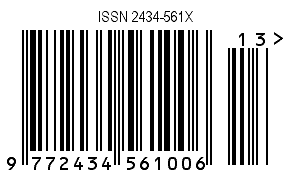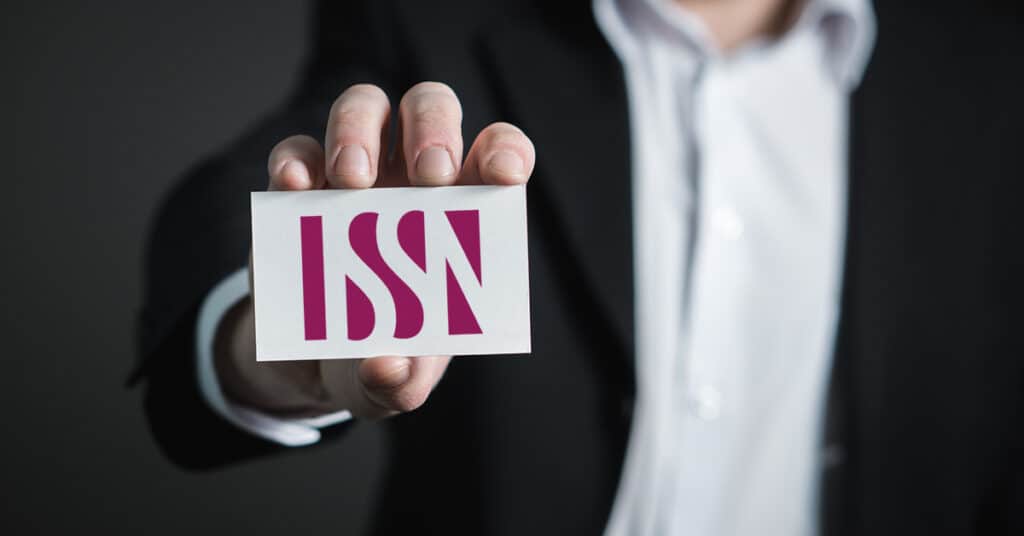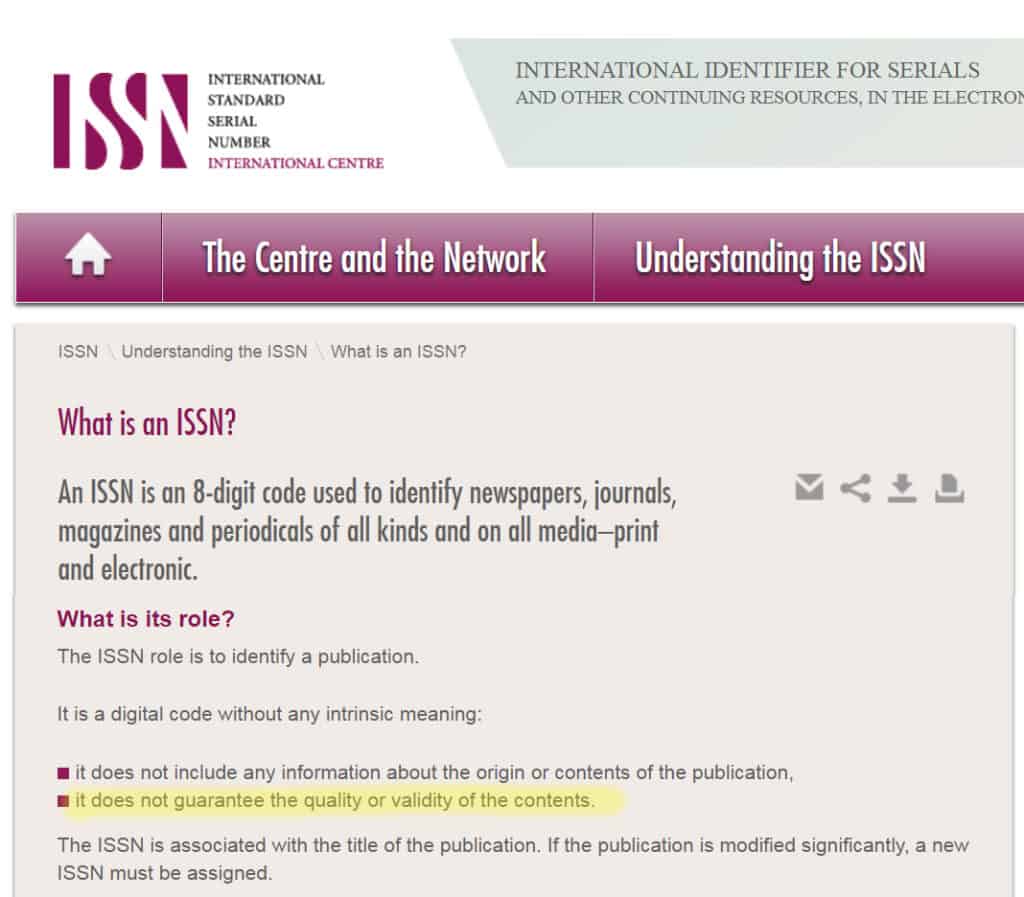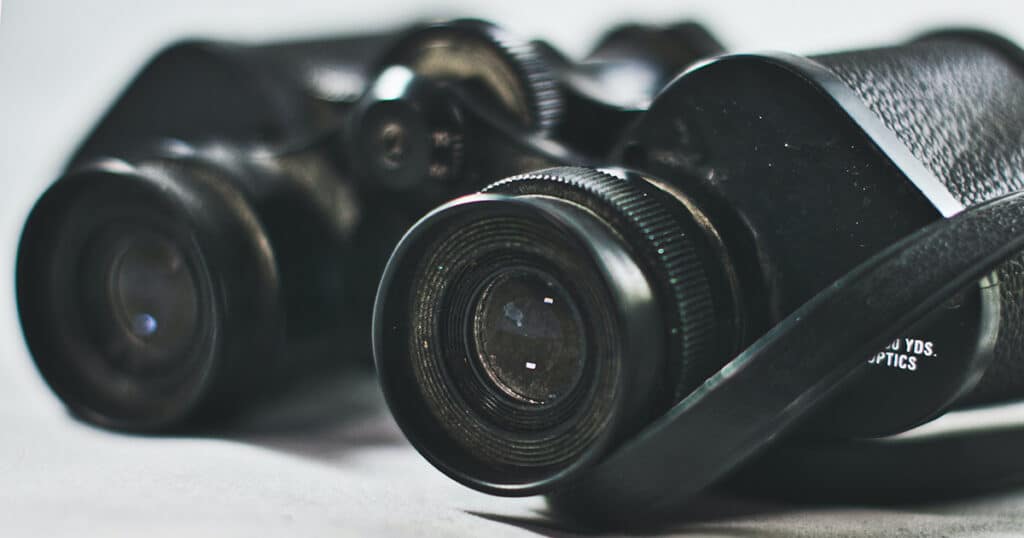Disclosure: This page may contain affiliate links. This means, at no additional cost to you, we receive a commission if you click through and make a purchase.
As scholars, who publish scientific papers, we often hear the term “ISSN”, but what does it mean, do you need one, how do you get one and what assumptions can you make about an ISSN? In this article, we explore these questions.
An ISSN (International Standard Serial Number) uniquely identifies all types of print and electronic media, such as scientific journals, magazines and newspapers. It is important that it is a periodical. An ISSN is represented by an eight-digit code, often separated in the middle by a hyphen. The digits that make up the ISSN have no meaning in themselves, they just have to be unique from all other ISSNs.
Why do ISSNs exist?
In many aspects of life, we need to be able to uniquely identify something. This might be to identify you as a customer for (say) an electricity provider, for the tax office or as a member of an organisation.
It is not just individuals that need to be identified. In a warehouse each item will have an SKU (Stock Keeping Unit) and in a shop each item will have a Product Code. Even airports have a unique three-digit code so that we can differentiate one airport from another, which is very important for many areas of airport operations, not least of all making sure that our baggage gets to the right place.
Scientific publishing is no different. We have to have a way of uniquely identifying certain elements within this area of our lives. DOI (Digital Object Identifier) is one aspect, which provides a unique way to identify a paper. An ORCID (Open Researcher and Contributor ID) identifier is a way to uniquely identify a single author.
An ISSN is just another form of unique identifier, in this case it identifies some form of electronic or print media. In the context of this article, an ISSN identifies a scientific journal.
Just to be clear, an ISSN will be unique to a specific journal. It is not unknown for two journals to have the same name, or almost the same name, which is a tactic used by some predatory journals to try and trick researchers into submitting their journal. However, two journals cannot have the same ISSN; each one will be different.
The ISSN system
The ISSN system is managed by an international centre in Paris. They take responsibility for assigning ISSNs in France and also for countries that do not have their own national centre.
There is a network of more than 80 centres across the world who take responsibility for assigning ISSN’s in their respective countries.
Is there an ISSN standard?
The ISO (International Organization for Standardization, yes, we know the acronym does not match the wording) has a standard on ISSN (ISO 3297:2017) which provides a definition of an ISSN, namely “Each International Standard Serial Number (ISSN) is a unique identifier for a specific serial or other continuing resource in a defined medium.“
Does a journal need an ISSN?
No, a journal does not need an ISSN.
It is perfectly okay to publish a journal, and many do, without an ISSN. This does not mean that the journal is better or worse than a journal with an ISSN, although some will try to give the impression that a journal with an ISSN has some mark of quality about it.
On the ISSN web site, it specifically says “ [an ISSN] does not guarantee the quality or validity of the contents” (see image below).
Why would you apply for an ISSN?
Having an ISSN does provide some credibility to your publication, even if that is unwarranted as ISSNs are relatively easy to get and are no measure of quality. But having an ISSN does provide a unique identifier, which may help others when searching for your publication.
As ISSN’s are for publications that are produced regularly, it also helps tie them together, so that readers know that they are reading the same periodical.
How much does an ISSN cost?
ISSNs are free, at least for the countries we look at. This is different to ISBNs (International Standard Book Number), which have a charge.
This would seem to be another good reason to get an ISSN. As they are free, there does not seem to be a downside?
What are the guidelines for requesting an ISSN?
Each country has its own guidelines but the ones we looked at are similar in the advice they offer.
You can see the guidelines produced by India at this link, but we have downloaded and made it available from this link, just in case the links stops working.
Some of the common guidelines we saw include:
- ISSNs are available at no charge.
- An ISSN can be revoked if it is shown that misleading information was provided at the time it was requested.
- ISSNs are assigned for certain categories of print/electronic media, including serials, journals and magazines. The ISO (International Organization for Standardization) provides some information about what types of material are suitable for an ISSN. They say that “ISSN are applicable to serials and to other continuing resources, whether past, present or to be published or produced in the foreseeable future, whatever the medium of publication or production.”
- Books cannot be assigned an ISSN. They require and ISBN.
- In some cases you can apply for an ISSN before publication but the general rule seems to be that you either need to wait until you have proof of publication or the ISSN will not be formally assigned until you have proof that the publication exists, even if you have previously applied and have been assigned an ISSN.
- For online publications, an ISSN can only be assigned after the first issue has been released.
- The guidelines on journals are particularly interesting. In India, for example (but other countries have similar guidelines), they have these guidelines.
- There should be a minimum of five editorial board members.
- Official postal and email addresses should be provided. The emails should have an institutional domain and personal email addresses (such as Yahoo and Gmail) should be avoided.
- The editorial board should be international in its make-up, with some members being from respected institutions from overseas.
- An ISSN can be withdrawn if plagiarism is detected.
- For non-annual e-journals, five articles is the minimum for a complete issue. Annual publications require ten articles for a complete issue.
- Editorial board members should be senior faculty members. Students, research fellows etc. should be avoided.
- The name and complete postal address (specifically India) of the publisher must be displayed on the publication or publication website. It is particularly important for the name of the publisher and the place of publication to be printed or displayed on the serial.
- There should be a minimum of five editorial board members.
It should be noted that these guidelines apply to an application for an ISSN. Whether breaching these guidelines after the ISSN has been assigned will lead to it being revoked, we are unsure.
How do you apply for an ISSN?
It is relatively easy to get, or at least apply for, an ISSN, but it does depend on what country you are in.
If you look at the ISSN web site, specifically the area on “Requesting an ISSN”, you will be asked to provide your country. This will then link you to the country agent(s), typically with a “Contact Us” button and a “Submit Your Request” button.
At the time of writing, the UK page asked for a form to be filled in, which has to be sent to British Library. In fact, you can access this form through the ISSN web site, but you can access a similar form through the British Library itself.
If we look at another country, let’s say Australia, you will be routed to their page. This also leads to a form that has to be submitted.
So, the exact method of applying for an ISSN will different from country to country but from looking at various countries it appears to be a pretty simple, straight forward process and they generally ask for similar information.
What do the eights digits mean?
An ISSN is made up of eight digits, which are all numbers, although the last digit can be an ‘X’. This last digit is actually calculated from the other seven digits.
The numbers in an ISSN have no meaning. This is different to an ISBN, where each part of the 13 digits has a meaning, or a DOI, where the first part represents the organisation that requested it. Our article has more details.

The only digit that has a meaning is the last one. This is known as a check digit and its role is to ensure the integrity of the other seven digits. This means that if one of the other seven digits changes, or the check digit changes, then it can be shown that there is an error in the ISSN number.
If you want to know how the check digit is calculated, the Library of Congress has an explanation.
What is ISSN-L?
You may see the term ISSN-L, which refers to a “linking ISSN”. This is a type of ISSN that groups together different media formats of the same serial publication.
We have not seen linking ISSNs used very often. In our experience, it is more common to see a journal with a print ISSN and a separate electronic ISSN.
Displaying or printing the ISSN
The standard way to display (or print) an ISSN is:
- ISSN followed by a space
- The first for digits
- A hyphen
- The last four digits
For example, (without the quotes when displaying/printing), “ISSN 1476-4687”, which is the ISSN for the journal Nature.
Conclusion
ISSN’s are probably more applicable to publishers than they are to authors and, as an author, ISSNs can almost be ignored.
For publishers, it might be important to have an ISSN, as it provides the rest of the world some way of uniquely identifying your publication. An ISSN also comes with some credibility, even though that might not be justified.
As an author, you may not ever care about ISSNs. It may become important when you are trying to track down a specific journal. Certainly, for this web site, ISSNs are important as it can enable us to differentiate between journals, which is not always as easy as it sounds. To give another example, we have also used ISSN’s in our bibliographic databases as a way to group the same journals together as, even for the same journal, they are sometimes spelt differently.
Most people reading this article will never need to apply for an ISSN but, if you do, it is a pretty easy process and it is free.



